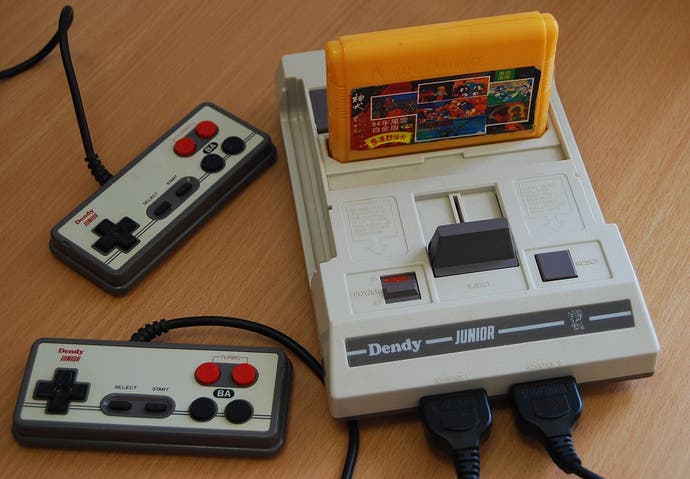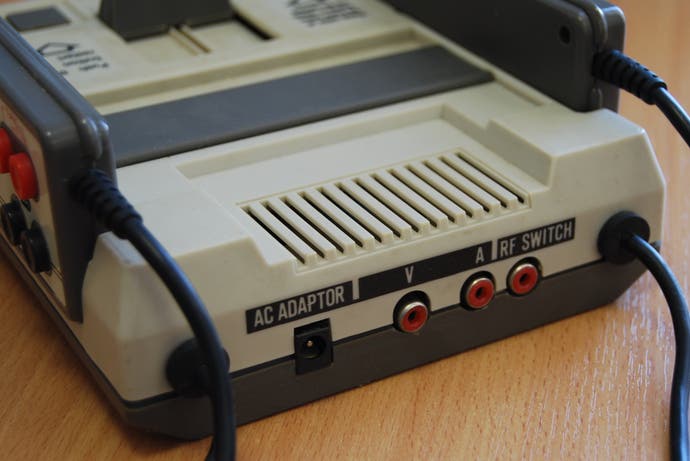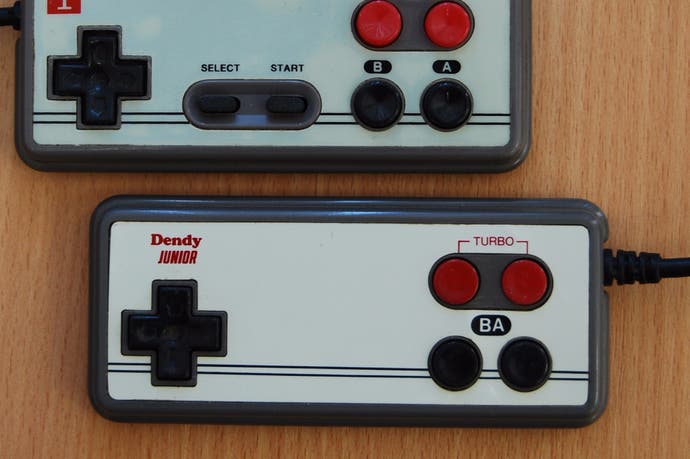How a counterfeit NES console opened up the Russian games market
The story of Dendy.
Back in the 90s, if you had mentioned the names Nintendo and Sega to a kid in America, Japan or Europe, their face would have likely lit up. They'd instantly know what these words represented; the colour and excitement of a game on the TV screen in their front room, and a sense of fun. But if you said these words to a child in Russia, they'd have looked at you blankly. These companies were not present in the region at the time. Say 'Dendy', however, and you'd invoke that same kind of magic.
This was a counterfeit NES console that was released in December 1992 by a Russian technology company called Steepler. It all began when Victor Savyuk, then working at another tech firm called Paragraph, first learnt of 'TV games'; machines that plugged into your TV at home, were controlled with joysticks and let people enjoy video games.

This was brand new information; games were far from a mainstream idea at the time, rather being confined to computers which were owned by a very small percentage of the population.
"I didn't understand at first, but I finally got it," Savyuk says.
"Of course, everybody likes to play games, but in those times, video games were only on computers. They were absolutely not mass market. They were just for freaks, for programming engineers. I immediately understood that this was the future. Thanks to Nintendo and Sega, and Atari before them, this business existed and it was huge - but it wasn't in Russia. I understood that this was the future, this was a place for new business in Russia."
Savyuk approached tech company Steepler, which made printers and computers, to make Dendy and went on to launch the firm's games division as this arm's sole employee. With this came the backing and logistics to make his dream a reality.
"We understood from the start that we were selling counterfeit products, but the first thing you have to understand is that in that time in Russia, intellectual property was not protected," he explains.
"The law didn't protect IP like games, consoles in Russia. There, our business was absolutely legal. But of course, in America and Europe it was completely illegal. And of course, Taiwanese manufacturer did not care about that."
What would become Dendy was built in a factory in Taiwan, largely due to the fact that machines from China were famed for their low quality. But there was one, admittedly pretty major, catch - Savyuk had no idea what a games console looked like, let alone what tech they needed under the hood.
"I was sending a lot of faxes to the manufacturer to find out what the console looked like," he says.
"Even at this time, I had never seen a console or a TV game; I had no idea how it worked, it was just a fantasy in my mind. They asked me a lot of questions: 'What kind of console do you want - 60 pins or 72 pins?' I had no idea what they meant; I didn't know the difference between Nintendo, Famicom... I knew nothing about it. I just knew the idea. I don't know what they thought about this stupid, crazy Russia man who was sending these faxes asking for 10,000 units and understanding nothing about this console.
"They sent me an example in October 1992. I put in the TV cable, switched it on and realised that this was the bomb. This would absolutely explode in the market."
Savyuk's first major hurdle, creating the machine, was behind him, but now he faced another, arguably bigger, one - explaining what a games console was to a country that largely had no idea about this brand new entertainment medium.
To help him in this process, Savyuk turned to illustrator Ivan Maximov to design a mascot for the machine.
"I just tried to draw different playful characters and the name came up in parallel," Maximov explains.
"I really love elephants and other animals with trunks. At the same time Victor had a nose which reminded me a trunk."
That was just one step. Savyuk then turned to television advertising, complete with its own jingle, to sell the console.
"I had to put a lot of money in advertising just to explain what TV games were," he says.

"I needed a name that people could use instead of TV game. So, I put a lot of money into advertising just for the Dendy brand name, we had a nice elephant mascot so people understood that it was something fun, but they understood nothing else about it. When I showed the console to someone, I said 'This is Dendy'. A few years later, people were asking 'What kind of Dendy do you have, Nintendo or Sega?'. That might sound strange to someone from the UK, but it was absolutely a real situation in Russia. It was what I wanted to do. Of course, when you have a brand name this was a protection for my sales, my distribution and so on."
This might sound far-fetched to someone in the west; a counterfeit console with a marketing budget being advertised on TV with its own jingle. But Nintendo had no interest in the Russian games market. And even if they had, the company would have no legal standing in the country.
"The first thing you have to understand is that we absolutely followed the rules and laws in Russia," Savyuk explains.
"So, it's very important. I did not make advertising for 'counterfeit console'; I did not make an advert for a Nintendo console. I made advertising for Dendy console. Dendy was, of course, made as a counterfeit console of the Famicom, but nobody knew that. For people, it was just a box with a Dendy logo, an elephant and it played TV games. Who could have attacked me? Only Nintendo, but not in Russia. I was very careful when I first contacted Nintendo of America because my lawyer asked me whether we were okay. In the territory of America, we were pirating so we could have a big problem there.
"When we started the campaign, we did nothing wrong. Nintendo was not represented in Russia. Nobody could ask us: 'What is this? It's counterfeit'. Even if someone did ask, they could do nothing in Russia because there was no law about that in Russia at the time."
The machine wasn't exactly a smash hit when it launched in stores. Having been released in December 1992, it went on to sell between 2000-3000 units a month for the first six months. This was, in part, due to the fact that the machine used the French SECAM (sequential colour with memory) standard rather than the more common PAL, which made the console pretty expensive at launch.
"I said this was a big mistake because people who were able to buy video games were already buying modern TVs, mostly Japanese, which had both systems, PAL and SECAM, so it's no problem," Dmitry Agarunov, who at the time ran one of Moscow's biggest games stores, stocked with lower quality Chinese fakes, explains.
"Their console ordered from Taiwan was much more expensive than a PAL one. They didn't listen and they started to import SECAM systems so I didn't even buy any of them."
So, the following May, Savyuk built a new machine called Dendy Junior. It launched in June 1993, with a new design and lower price and with Savyuk doing his best do make his hardware the best possible option for games retailers.
"My idea was to explain to game stores why they should buy in China when they could buy from my warehouse of stock - it was more profitable for them, so if they would just do it with us and, we would guarantee everything about the console was quality, with brand name, advertisement and everything," he explains.
"We tried to build a wholesale system. We finally did it and when we launched Dendy Junior in June, by August we were selling 70,000 consoles a month. We made our first $1m in a month that August. The business was lifted. Everything before in advertisement and awareness of quality and brand name and logistics started to work."

Agarunov adds: "I almost bought everything that they ordered and made a good a profit. It was a proper console plus it came with a warranty. For me it was great because I have to send a big percentage of the consoles I was buying in China back because they were broken. I made my own guarantee for my customers so it was costing me money. I asked why I should import when I could buy locally. It was very convenient for me. Plus it had TV advertising - they invested a lot of money in TV advertising. For me it was an obvious decision."
Ultimately, Dendy sold between 1.5m and 2m units in Russia. Then in 1994, the newly-formed Dendy Company subsidiary of Steepler was invited to visit Nintendo of America president Minoru Arakawa and its chairman Robert Lincoln. There, the two companies signed a deal which not only gave Steepler the distribution rights for SNES in Russia; Nintendo also forgave them for selling a counterfeit machine.
"Nintendo understood that we built the market and that it was now ready for 16-bit consoles like the Super Nintendo, and we agreed that we would sell only originals," Savyuk says.
"We started this business in December 1994 and sold a lot of consoles."
That is what Savyuk is most proud of when it comes to this story; that with Dendy, he pretty much single-handedly opened up the Russian games market to the world.
"My real pride in this story is only that I could build this business," he says. "We kept around 70 per cent of the market for years."
"If Nintendo and Sega had been in the market and we had tried to make some kind of competition, we might have succeed but we wouldn't have opened up the market. If you open this market, and there is no Sega or Nintendo, you are the big boss of this market. There were a lot of very similar stories in other businesses in Russia from that time. We are not alone."
Agarunov concludes: "They made this market. They imported millions of consoles into the country and they built this market. This is how the Russian games industry was born. It's how Russian people started to play video games."


